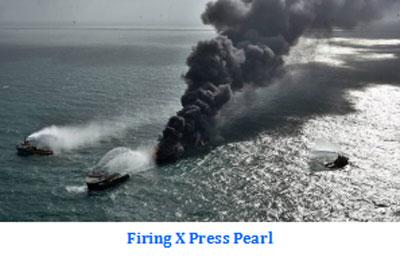Reply To:
Name - Reply Comment
In general, scientists are more concern on air pollutant emission by major sources such as Power industries, Non-combustion activities, Other industrial combustions, Transportation activities, Building sector activities and Natural processes (Volcanoes and Forest fire etc.). As a result of that, the emission loads have been estimated for major pollutant emission sources for a particular time period as one month, one-year etc. But the estimation of pollutant loads added to the atmosphere by natural processes is quite difficult. According to the Green House Gas (GHG) Emission inventory, the total load of CO2 emission by each sector can be summarized as follows.

As shown in the above figure, it is well clear that transportation sector generates the largest share of CO2 gas emissions. In 2020, CO2 emissions from transport sector in Sri Lanka, was 9 metric tons. CO2 emissions from transport sector increased from 1 metric tons in 1971 to 9 metric tons in 2020, growing at an average annual rate of 4.42%. In 2021, CO2 emissions from domestic aviation was 2,184 tons.
 But there may be some hidden activities, processes, disasters, etc. (manmade or natural) that could be released more emission to atmosphere than we expect. The very recent example is accidental fire occurred at the MV X-Press Pearl ship.
But there may be some hidden activities, processes, disasters, etc. (manmade or natural) that could be released more emission to atmosphere than we expect. The very recent example is accidental fire occurred at the MV X-Press Pearl ship.
MV X-PRESS PEARL was a Singapore-registered Super Eco 2700–class container ship which had carried approximately 1,486 containers of chemicals and materials out of 81 cargos containing dangerous chemicals. As per the collected information, chemicals in the ship included Nitric acid (25 Mt), Sodium hydroxide (1,040 Mt), Sulphur (525 Mt), Methanol (210 Mt) and onboard fuel oil (322 Mt), etc. The materials include 11,000 Mt of plastics, 3,000 Mt of metals, 2,500 Mt of food items and 6,800 Mt of other materials, etc.
The ship was arrived at Colombo harbour on late hours of 19th May 2021. Before entry to the Colombo port, it was anchored outer harbour at about 9.5 NM (about 18 km) away from the Colombo port and a fire had been erupted on board during the evening of 20th May 2021, involving containerized products and chemicals stored over the forward section. The fire was reported at the position where 25 metric tons of nitric acid was stored. Other hazardous and noxious chemicals had been stored within close proximity. Despite swift firefighting, the fire was not able to be extinguished and continued to escalate, partly supported by the monsoon winds. The fire was continued till 30th May and few explosions were reported on-board the vessel during the firing. This situation presents the risk of pollution of the waterways and air with hazardous and noxious materials, with the potential for environmental impact and threat to the health of responders, crew on surrounding vessels and persons onshore.
 As per the evaluation conducted by National Building Research Organisation (NBRO) of the fire at the X-Press Pearl ship, 43% out of the total storage was susceptible to be burned. Furthermore, Epoxy resin has been accounted for 49% out of the total amount susceptible to be burnt, food items had been accounted for 18%, three types of Polyethylene beads (High-Density Polyethylene, Low-Density Polyethylene, Linear Low-Density Polyethylene) had been accounted for 10%.
As per the evaluation conducted by National Building Research Organisation (NBRO) of the fire at the X-Press Pearl ship, 43% out of the total storage was susceptible to be burned. Furthermore, Epoxy resin has been accounted for 49% out of the total amount susceptible to be burnt, food items had been accounted for 18%, three types of Polyethylene beads (High-Density Polyethylene, Low-Density Polyethylene, Linear Low-Density Polyethylene) had been accounted for 10%.
“The estimation indicated that total of 2,296 tons of SO2, 328 tons of NO2, 892 tons of CO, 105 tons of PM, 11,061 tons of CO2 and more than 1,334 mg of Dioxin and Furan were added to the atmosphere by the fire.”
Air Pollutant Dispersion
The “AERMOD/ ISCST3” model was used to simulate the ground level pollutant concentration due to the ship fire. The results indicated that the average 1-hour ground level CO2 concentration were exceeded in the level 10,700 µg/m3 at land area of 58 km2. The area about 4,568 km2 has recorded average 1-hour concentration of NO2 above 500 µg/m3 and 1-hour average concentration of SO2 above 4,000 µg/m3 in the area of 2,868 km2.
The simulation results further indicated that the average 24-hour ground level CO2 concentration of 100 µg/m3 were exceeded at about 2,788 km2 and the average 24-hour ground level NO2 concentration of 100 µg/m3 were exceeded at about 2,347 km2 at land area. The area about 2,320 km2 has recorded average 24-hour concentration of SO2 above 250 µg/m3 and 24-hour average PM10 level of 50 µg/m3 recorded at about 185 km2.
As a result of that, the contribution of air pollutants generated by the ship’s fire could be significantly affected to the ambient air quality levels in Sri Lanka. Therefore, incidental pollutant emissions should have more concern than the conventional pollutant sources to improve the quality of Blue Sky.


